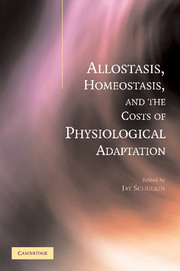Book contents
- Frontmatter
- Dedication
- Contents
- Preface
- Contributors
- Introduction
- 1 Principles of Allostasis: Optimal Design, Predictive Regulation, Pathophysiology, and Rational Therapeutics
- 2 Protective and Damaging Effects of the Mediators of Stress and Adaptation: Allostasis and Allostatic Load
- 3 Merging of the Homeostat Theory with the Concept of Allostatic Load
- 4 Operationalizing Allostatic Load
- 5 Drug Addiction and Allostasis
- 6 Adaptive Fear, Allostasis, and the Pathology of Anxiety and Depression
- 7 A Chronobiological Perspective on Allostasis and Its Application to Shift Work
- 8 Allostatic Load and Life Cycles: Implications for Neuroendocrine Control Mechanisms
- Commentary: Viability as Opposed to Stability: An Evolutionary Perspective on Physiological Regulation
- Index
8 - Allostatic Load and Life Cycles: Implications for Neuroendocrine Control Mechanisms
Published online by Cambridge University Press: 05 February 2015
- Frontmatter
- Dedication
- Contents
- Preface
- Contributors
- Introduction
- 1 Principles of Allostasis: Optimal Design, Predictive Regulation, Pathophysiology, and Rational Therapeutics
- 2 Protective and Damaging Effects of the Mediators of Stress and Adaptation: Allostasis and Allostatic Load
- 3 Merging of the Homeostat Theory with the Concept of Allostatic Load
- 4 Operationalizing Allostatic Load
- 5 Drug Addiction and Allostasis
- 6 Adaptive Fear, Allostasis, and the Pathology of Anxiety and Depression
- 7 A Chronobiological Perspective on Allostasis and Its Application to Shift Work
- 8 Allostatic Load and Life Cycles: Implications for Neuroendocrine Control Mechanisms
- Commentary: Viability as Opposed to Stability: An Evolutionary Perspective on Physiological Regulation
- Index
Summary
INTRODUCTION
Animals live in environments that change predictably over time, and individuals adjust their life cycles in anticipation of those changes. Habitat variation is most predictable at middle and high latitudes where short days of autumn and winter are accompanied by low primary productivity (plant growth) resulting in decreasing food resources for most animals. Lengthening days of spring and early summer bring a resurgence of growth and increasing food abundance. It is not surprising then that many vertebrates breed in spring when resources are increasing. This maximizes the chances for reproductive success. Even those animals that mate or give birth in autumn and winter time the period of maximum food requirements for feeding young with spring and summer (Lack, 1968; Bronson, 1989). In tropical regions, resources for breeding also fluctuate but often on a more variable time scale. The most well-known seasonal change in the tropics is rainfall, but the onset of the rainy season can vary in timing and amount from year to year. Thus, animals time breeding to coincide with maximum plant growth and subsequent fruit and insect production – or with the end of the rainy season when densities of young animals are great, in the case of many predators and vultures (Brown and Britton, 1980). Virtually all of these vertebrate organisms must initiate gonadal development, and many migrate to favorable breeding areas in anticipation of the onset of environmental conditions that are conducive to breeding. Equally important is termination of the reproductive period and gonadal regression as, or before, resources for breeding decline. Many species then undergo a molt, and migratory populations move back to wintering areas. These major changes in life history stages (LHSs; Jacobs and Wingfield, 2000) require profound adjustments of physiology, morphology, and behavior.
Although predictable cycles of morphology, physiology, and behavior are easily studied at the population level (e.g., daily, seasonal, tidal rhythms), individuals must also regulate their life cycles differently according to social status, body condition, parasite load, and so on. For example, resources for breeding are rarely distributed uniformly through the environment.
- Type
- Chapter
- Information
- Publisher: Cambridge University PressPrint publication year: 2004
- 9
- Cited by

